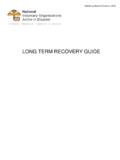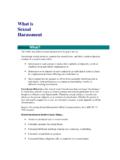Transcription of Life Cycle Assessment of Disposable and Reusable Nappies ...
1 W w life Cycle Assessment of Disposable and Reusable Nappies in the UK. The project was informed and assisted by an Advisory Board set up by the Environment Agency. Membership of the Advisory Board was decided by the Environment Agency on the basis of interest, balance and ability to assist in data collection. The Advisory Board members were: Stewart Begg Absorbent Hygiene Product Manufacturer Association (AHPMA);. Terry Coleman (Chairman) - the Environment Agency;. Geoff Davies - Swindon Unitary Authority;. Dr Ioannis Hatzopoulos Procter & Gamble Service GmbH;. Ann Link - Women's Environmental Network;. Joanna Marchant - the Environment Agency;. Gillian Neville Defra;. Vicki Portman - Plush Pants (one meeting); and Gina Purrman Real Nappy Association (resigned from Real Nappy Association Spring 2003. Replaced on the Advisory Board by Joanne Freer - Cotton Bottoms). The Environment Agency is the leading public body protecting and improving the environment in England and Wales.
2 It's our job to make sure that air, land and water are looked after by everyone in today's society, so that tomorrow's generations inherit a cleaner, healthier world. Our work includes tackling flooding and pollution incidents, reducing industry's impacts on the environment, cleaning up rivers, coastal waters and contaminated land, and improving wildlife habitats. This report is the result of research commissioned and funded by the Environment Agency's Science Programme. Published by: Authors: Environment Agency, Rio House, Waterside Drive, Aztec West, Simon Aum nier and Michael Collins Almondsbury, Bristol, BS32 4UD. Tel: 01454 624400 Fax: 01454 624409 Dissemination Status: Publicly available ISBN: 1 84432 427 3 Keywords: Cloth, Disposable , life Cycle Assessment , LCA, Environment Agency May 2005 Nappies , Reusable . All rights reserved. This document may be reproduced with prior permission of the Environment Agency. Research Contractor: Environmental Resources Management The views expressed in this document are not necessarily Eaton House, Wallbrook Court those of the Environment Agency.
3 North Hinksey Lane Oxford OX2 0QS. This report is printed on Cyclus Print, a 100% recycled stock, Tel: 01865 384 800. which is 100% post consumer waste and is totally chlorine free. Water used is treated and in most cases returned to source in Environment Agency's Project Manager: better condition than removed. Terry Coleman and Joanna Marchant, Head Office Further copies of this report are available from: Science Project reference: The Environment Agency's National Customer Contact Centre by P1-481 (SC010018). emailing or by telephoning 08708 506506. Product Code: SCHO0505 BJCW-E-P. 2 life Cycle Assessment of Disposable and Reusable Nappies in the UK. Foreword Even though we now recycle nearly 18 % of our 25 million tonnes of household waste we still landfill the majority of the remaining waste. We need to continue with the programme of actions to deliver much greater recovery and reuse of these materials. As we re-examine the impacts of what we produce, and the waste we generate we need a framework to decide what makes sense.
4 That is where life Cycle Assessment (LCA) can be used. It forces a rational examination of all the environmental impacts of products and services. 2-3% of our household waste is estimated to be Disposable Nappies , approximately 400,000 tonnes of waste each year. The alternative is to use Reusable Nappies . This reduces demands on landfill but Reusable Nappies impact on the environment in other ways such as the water and energy we use in washing and drying them. Both approaches therefore create their own environmental impacts. This study reported on the way people used the leading types of both Disposable and Reusable Nappies in 2002/3. As new products come onto the market place we will update this study and already plan to review the next generation of Nappies . We expect those developing these products to use this study to shape more sustainable designs of Nappies . These are steps forward but we still need to tackle the volume of Disposable products that go to landfill. If we take the Government's most optimistic forecasts we will still be landfilling over 350,000 tonnes of Disposable Nappies .
5 This is at a time when we aim to reduce the volume of biodegradable waste going to landfill and to deliver more sustainable waste management. Therefore we want the main manufacturers of Disposable Nappies to work with us to find ways to reduce the volumes that go to landfill. We also look to Reusable nappy manufacturers to help parents review the way they launder and dry Reusable products to reduce their water and energy impacts. This LCA study provides the framework against which we can judge the success or failure of actions to reduce the impacts of Reusable and Disposable Nappies . Further information on this study and on how you can reduce environmental impacts from the use of Reusable and Disposable Nappies and related products is on our website at Tricia Henton Director of Environmental Protection life Cycle Assessment of Disposable and Reusable Nappies in the UK 3. Executive Summary In recent years, there has been considerable debate over the relative environmental performance of Reusable (cloth) Nappies and Disposable Nappies .
6 While many people intuitively think that Reusable Nappies are better for the environment, Disposable Nappies account for some 95 per cent of the market and around billion Disposable Nappies are sold in the UK each year. The environmental impacts of different nappy types have been investigated in numerous studies. However, these studies have been limited in their accuracy or in their scope and have often been carried out by, or on behalf of, an organisation with a vested interest in the study results. In 2001, the Environment Agency commissioned the environmental consultancy Environmental Resources Management Limited (ERM) to provide an independent and objective environmental life Cycle Assessment of nappy use in the UK. life Cycle Assessment (LCA) is a technique used to assess environmental performance over the entire life Cycle , from raw material extraction through to product manufacture, use and final disposal. The study reported here complies with the latest methods laid down in international standards (ISO14040).
7 Study aims The aim of the LCA study was to assess the life Cycle environmental impacts associated with using Disposable Nappies and Reusable Nappies in the UK for 2001- 2002. Three different nappy types were assessed: Disposable Nappies ;. home laundered flat cloth Nappies ; and commercially laundered prefolded cloth Nappies delivered to the home. The systems studied To compare the Nappies fairly, the study considered the environmental impacts associated with an average child wearing Nappies during the first two and a half years of its life . 4 life Cycle Assessment of Disposable and Reusable Nappies in the UK. For each nappy type studied, all the materials, chemicals and energy consumed during nappy manufacture, use and disposal, and all the emissions to the environment were identified. All these flows' were quantified and traced back to the extraction of raw materials that were required to supply them. For example, polymer materials used in Disposable Nappies were linked to the impacts associated with crude oil extraction and the flows associated with the fluff pulp used in disposables were traced back to paper and forest growth.
8 For cloth Nappies , the flows were traced back to cotton growth and production. All transport steps have been included. The environmental impact categories assessed were those agreed by the project board: resource depletion; climate change; ozone depletion; human toxicity;. acidification; fresh-water aquatic toxicity; terrestrial toxicity; photochemical oxidant formation (low level smog) and nutrification of fresh water (eutrophication). These environmental impacts were calculated for an average nappy system in each case. The study therefore excluded impacts such as noise, biodiversity and the amount of land used by each system. The total flows of each substance were compiled for each stage of the life Cycle and used to assess the environmental impacts of each system. For example, flows of methane, carbon dioxide and other greenhouse gases were aggregated for each system in total. Internationally agreed equivalents that quantify the relative global warming effect of each gas were then used to assess the overall global warming impact of each nappy system.
9 Figure 1 shows the system that was studied for commercially laundered cloth Nappies . For the three nappy systems, manufacturers provided data for their production processes. Commercial laundries also supplied data. Published excreta data was used for the contents of used Nappies . Data on the numbers of different Nappies in use and how they were washed etc. were estimated from surveys undertaken for the Environment Agency (1). Published life Cycle inventory data were used to describe commodity material and energy inputs to the stages. Sensitivity analyses were conducted for the following key areas of uncertainty: Reusable nappy manufacture;. aquatic toxicity impact method;. drying methods for Reusable Nappies ; and how excreta were disposed of. (1) Environment Agency, 2004 Time to change? A study of parental. habits in the use of Disposable and Reusable Nappies . Environment Agency. life Cycle Assessment of Disposable and Reusable Nappies in the UK 5. Figure 1 Commercially laundered cloth Nappies Environment: Resources Cotton O.
10 Cultivation E and Cotton Ginning Cotton Spinning T. N Harvesting H. E T E. R Fabric Production R. Fertiliser and G Pesticide and Wet Production Processing Y. P. Other Nappy Packaging T. Nappy T Construction R. Production Construction Materials S O. U T D. P Detergent Retail and Wrap and U. Manufacture Liner T. P T Distribution Manufacture C. L T. T. Y. Laundry Service Water Treatment and T. S. S Supply Sewage Y. Consumer Use Treatment Y S. T. S T. Packaging Waste T Disposal E. E M. M S. S. Environment: Air, Land and Water 6 life Cycle Assessment of Disposable and Reusable Nappies in the UK. Conclusions For the three nappy systems studied, there was no significant difference between any of the environmental impacts that is, overall no system clearly had a better or worse environmental performance, although the life Cycle stages that are the main source for these impacts are different for each system. The study was supported by a stakeholder group representing the interested parties and is the most comprehensive, independent study of its kind.







